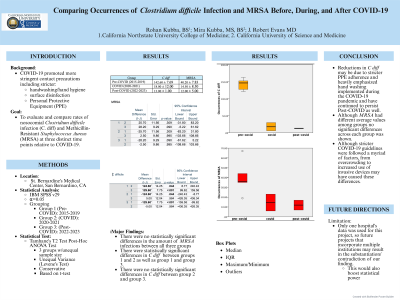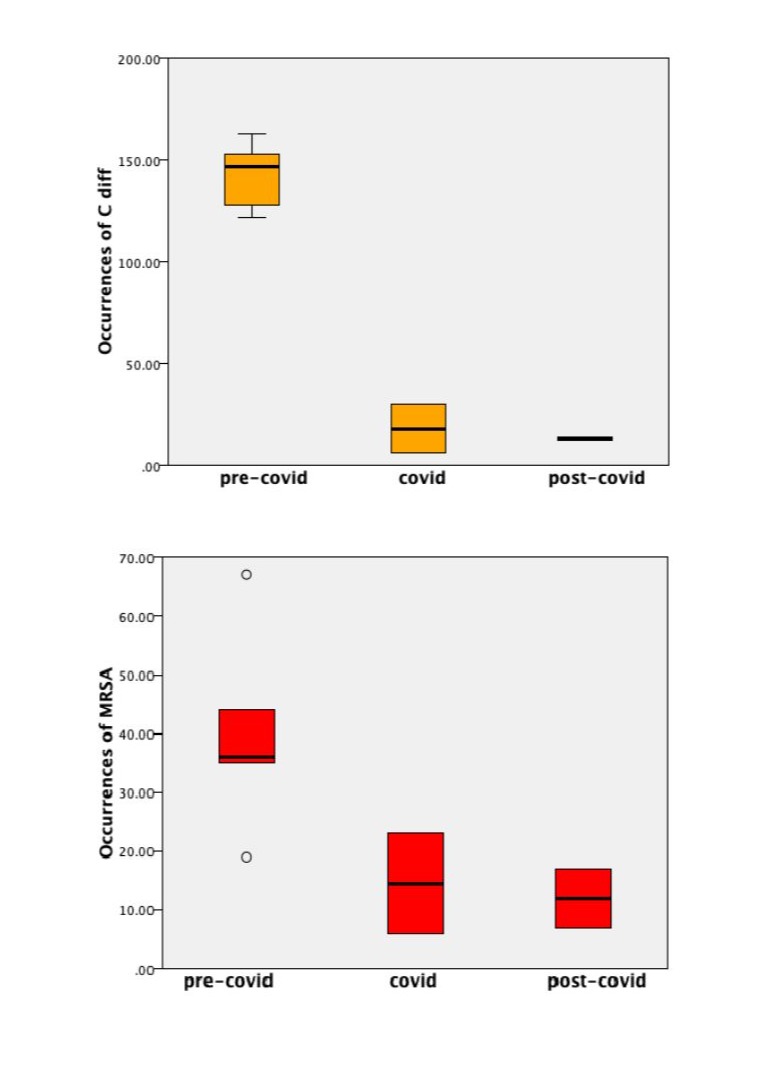Sunday Poster Session
Category: Colon
P0246 - Comparing Occurrences of C diff and MRSA Before, During, and After COVID-19
Sunday, October 27, 2024
3:30 PM - 7:00 PM ET
Location: Exhibit Hall E

Has Audio

Rohan Kubba, BS
California Northstate University College of Medicine
Redlands, CA
Presenting Author(s)
Rohan Kubba, BS1, Mira Kubba, MS, BS2, J Robert Evans, MD, FACG3
1California Northstate University College of Medicine, Redlands, CA; 2California University of Science and Medicine, Redlands, CA; 3St. Bernardine's Medical Center, Redlands, CA
Introduction: Downstream effects of the COVID-19 pandemic are changes in hospital behaviors, including a greater emphasis on frequent hand washing, facemasks, and high adherence to PPE standards. Because of stricter hospital guidelines, we surmised that there may be significant differences in occurrences of Clostridioides difficile infection, or C diff, (ICD-10: A04.7) from pre-covid (2015-2019), covid (2020-2021), and post covid (2022-2023) at St. Bernardine’s Medical Center in San Bernardino, California. We also evaluated methicillin-resistant Staphylococcus aureus, or MRSA (ICD-10: B95.62) occurrences to assess if another common hospital infection had significant occurrence differences among groups.
Methods: Statistical analysis was generated through version 29 of IBM’s SPSS. An α=.05 was chosen. Group 1 consisted of C diff and MRSA occurrences from 2015-2019 at St. Bernardine’s Medical; Group 2 consisted of C diff and MRSA occurrences from 2020-2021, and Group 3 consisted of C diff and MRSA occurrences respectively from 2022-2023. We specifically utilized Tamhane’s T2 Post-Hoc ANOVA test. This test was chosen because it accounts for variance and sample size differences across groups.
Results: C diff occurrences yielded a pre-covid, covid, and post-covid mean and standard deviation of 142.60±7.69, 18.00± 12.00, and 13.00± 1.00, respectively. MRSA occurrences yielded a pre-covid, covid, and post-covid mean and standard deviation of 40.20± 7.83, 14.50± 8.50, and 12.00± 5.00, respectively. Our analysis detected a statistically significant difference between the pre-covid group and covid group in occurrences of C diff infection as well as between the pre-covid and post-covid groups. We found no significant differences between the covid and post-covid groups with regard to occurrences of C diff. We found no statistically significant differences between any groups with regard to MRSA.
Discussion: Our results suggest that there were significant reductions in C diff occurrences across each group with the exception of no significant differences between covid and post-covid. This implies that the reduction may be due to stricter PPE adherence implemented during the covid pandemic and have continued to persist post-covid as well; however, this idea may be challenged with nonsignificant MRSA occurrences across groups. We will only know if reductions in C diff will persist as more data becomes available with time.

Note: The table for this abstract can be viewed in the ePoster Gallery section of the ACG 2024 ePoster Site or in The American Journal of Gastroenterology's abstract supplement issue, both of which will be available starting October 27, 2024.
Disclosures:
Rohan Kubba, BS1, Mira Kubba, MS, BS2, J Robert Evans, MD, FACG3. P0246 - Comparing Occurrences of <i>C diff</i> and MRSA Before, During, and After COVID-19, ACG 2024 Annual Scientific Meeting Abstracts. Philadelphia, PA: American College of Gastroenterology.
1California Northstate University College of Medicine, Redlands, CA; 2California University of Science and Medicine, Redlands, CA; 3St. Bernardine's Medical Center, Redlands, CA
Introduction: Downstream effects of the COVID-19 pandemic are changes in hospital behaviors, including a greater emphasis on frequent hand washing, facemasks, and high adherence to PPE standards. Because of stricter hospital guidelines, we surmised that there may be significant differences in occurrences of Clostridioides difficile infection, or C diff, (ICD-10: A04.7) from pre-covid (2015-2019), covid (2020-2021), and post covid (2022-2023) at St. Bernardine’s Medical Center in San Bernardino, California. We also evaluated methicillin-resistant Staphylococcus aureus, or MRSA (ICD-10: B95.62) occurrences to assess if another common hospital infection had significant occurrence differences among groups.
Methods: Statistical analysis was generated through version 29 of IBM’s SPSS. An α=.05 was chosen. Group 1 consisted of C diff and MRSA occurrences from 2015-2019 at St. Bernardine’s Medical; Group 2 consisted of C diff and MRSA occurrences from 2020-2021, and Group 3 consisted of C diff and MRSA occurrences respectively from 2022-2023. We specifically utilized Tamhane’s T2 Post-Hoc ANOVA test. This test was chosen because it accounts for variance and sample size differences across groups.
Results: C diff occurrences yielded a pre-covid, covid, and post-covid mean and standard deviation of 142.60±7.69, 18.00± 12.00, and 13.00± 1.00, respectively. MRSA occurrences yielded a pre-covid, covid, and post-covid mean and standard deviation of 40.20± 7.83, 14.50± 8.50, and 12.00± 5.00, respectively. Our analysis detected a statistically significant difference between the pre-covid group and covid group in occurrences of C diff infection as well as between the pre-covid and post-covid groups. We found no significant differences between the covid and post-covid groups with regard to occurrences of C diff. We found no statistically significant differences between any groups with regard to MRSA.
Discussion: Our results suggest that there were significant reductions in C diff occurrences across each group with the exception of no significant differences between covid and post-covid. This implies that the reduction may be due to stricter PPE adherence implemented during the covid pandemic and have continued to persist post-covid as well; however, this idea may be challenged with nonsignificant MRSA occurrences across groups. We will only know if reductions in C diff will persist as more data becomes available with time.

Figure: Boxplots for C diff and MRSA Occurrences pre-covid, covid, and post-covid
Note: The table for this abstract can be viewed in the ePoster Gallery section of the ACG 2024 ePoster Site or in The American Journal of Gastroenterology's abstract supplement issue, both of which will be available starting October 27, 2024.
Disclosures:
Rohan Kubba indicated no relevant financial relationships.
Mira Kubba indicated no relevant financial relationships.
J Robert Evans indicated no relevant financial relationships.
Rohan Kubba, BS1, Mira Kubba, MS, BS2, J Robert Evans, MD, FACG3. P0246 - Comparing Occurrences of <i>C diff</i> and MRSA Before, During, and After COVID-19, ACG 2024 Annual Scientific Meeting Abstracts. Philadelphia, PA: American College of Gastroenterology.
